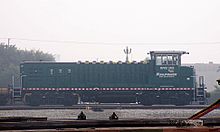This is an old revision of this page, as edited by Dellarb (talk | contribs) at 00:57, 29 October 2006. The present address (URL) is a permanent link to this revision, which may differ significantly from the current revision.
Revision as of 00:57, 29 October 2006 by Dellarb (talk | contribs)(diff) ← Previous revision | Latest revision (diff) | Newer revision → (diff)Hybrid Locomotive is a Locomotive or MU Train that uses an on-board rechargeable energy storage system (RESS) and a fuelled power source for propulsion.
Hybrid trains typically are powered either by Fuel Cell technology or the slightly more conventional diesel-electric hybrid which reduces fuel consumption through regenerative braking and switching off the hydrocarbon engine when idling or stationary (as used in autmobiles such as the Toyota Prius.
JR fuel cell train
In May 2003 JR East started test runs with the so called NE (new energy) train and validated the system's operability (series hybrid with lithium ion battery) in cold regions.
With two 65-kilowatt fuel cells and six hydrogen tanks under the floor and a secondary battery on the roof. It is capable of 100km/h (60mph) with a range of between 50 and 100 km (30 and 60 miles) without needing to be refulled.
Research is underway into the use of regernative braking to recharge the train's batteries which will increase range further. JR hopes to introduce the train to sheduled local service in the summer of 2007
RailPower diesel-electric hybrid shunting locomotive

In 2004, RailPower Technologies had been running pilots in the US with the so called Green Goats which led to orders by the Union Pacific and Canadian Pacific Railways starting in early 2005
The diesel-electric hybrid trains are expected to cut emissions between 80 to 90-percent and decrease fuel consumption between 40 to 60-percent compared to conventional diesel-powered locomotives. The Green Goats will be used in rail yards to separate to sort out railcars for inbound trains and lining up outbound trains.